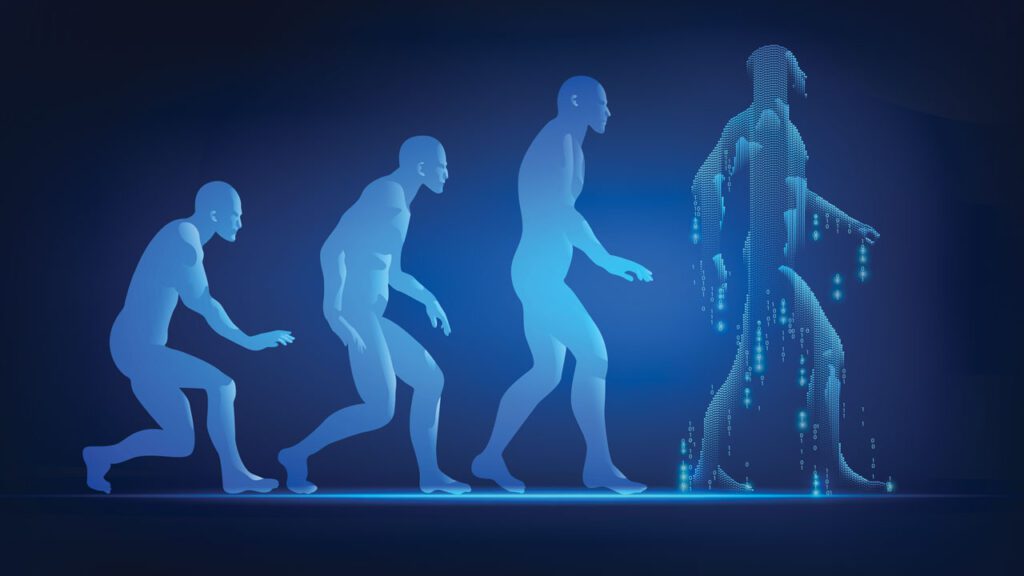AI and the evolution of life is transforming the way scientists study some of the deepest mysteries of existence. From understanding how life evolved on Earth to predicting how it might adapt in the future, AI is becoming an essential tool in the study of biology and evolution. Researchers are now able to analyze complex biological data, simulate ancient ecosystems, and explore genetic patterns with a speed and accuracy that would have been impossible just a few decades ago.
The study of evolution has always been challenging. Life on Earth has changed over billions of years, and understanding these transformations requires careful analysis of fossils, genes, and living organisms. Traditional methods often provide incomplete pictures because biological systems are incredibly complex and interconnected. AI, with its ability to process massive amounts of data and find patterns humans cannot easily see, is now bridging this gap.
Understanding the Basics of AI in Evolutionary Science
AI refers to computer systems that can perform tasks that normally require human intelligence. In the context of evolution, AI is most often used to analyze data, recognize patterns, and make predictions. Machine learning and deep learning, two branches of AI, are especially useful because they allow systems to learn from data and improve over time.

For evolutionary biology, this means AI can look at huge datasets containing genetic information, environmental factors, and species characteristics. It can then identify connections, predict outcomes, and even suggest new directions for research. In effect, AI acts like a powerful microscope, revealing patterns that are invisible to human researchers.
Decoding the Language of Life
One of the most exciting applications of AI in evolution is understanding proteins, the molecules that carry out essential functions in every living organism. Proteins are complex structures, and predicting how they fold and function has historically been one of biology’s greatest challenges.

AI models can now predict protein structures with astonishing accuracy. This capability is transforming biology because it allows scientists to understand how proteins evolved and how they contribute to the survival and adaptation of species. By comparing protein structures across different organisms, AI can reveal how unrelated species sometimes develop similar traits independently, a phenomenon called convergent evolution.
For example, certain adaptations, like echolocation in bats and whales, have evolved independently. AI can identify the molecular features that made these adaptations possible, helping scientists understand not only how evolution works but also the constraints and possibilities of life itself.
Simulating Evolution in Virtual Labs
Another revolutionary use of AI is simulating evolutionary processes. Traditionally, testing hypotheses about evolution required long-term experiments, fossil analysis, or observational studies that could take decades. AI simulations offer an alternative.
Using AI, scientists can create virtual environments where they simulate populations of organisms over thousands of generations. These simulations can model the effects of environmental changes, genetic mutations, and competition for resources. By observing these virtual populations, researchers can test theories about natural selection, genetic drift, and adaptation.
Such simulations are particularly valuable for understanding rapid evolutionary changes, like the development of antibiotic resistance in bacteria. By predicting how bacteria evolve in response to different drugs, AI helps researchers devise more effective treatment strategies and reduce the risk of resistant strains spreading.
AI and the Secrets of DNA
The genetic code carries the story of life’s evolution, and AI is now capable of reading that story in unprecedented detail. By analyzing entire genomes, AI can identify genetic variations that have allowed species to adapt to their environments over millions of years.
For instance, AI can detect small mutations that provide advantages under certain conditions. It can also track how these mutations spread through populations, offering insights into the speed and direction of evolutionary change. This level of analysis would be impossible without AI because of the sheer volume and complexity of genomic data.
AI is also helping scientists understand the evolution of extinct species by comparing ancient DNA with that of living organisms. This approach allows researchers to reconstruct evolutionary pathways, revealing how species emerged, diversified, and sometimes went extinct. The result is a more complete understanding of the history of life on Earth.

Predicting the Future of Life
One of the most powerful applications of AI is predicting how life might evolve in the future. By analyzing genetic, environmental, and ecological data, AI models can simulate how species might adapt to changing climates, new predators, or human influence.
These predictions are not just theoretical. They have practical implications for conservation biology, agriculture, and medicine. For example, AI can help identify species that are at risk of extinction due to environmental changes. It can also guide the development of crops that are more resilient to drought or disease. In medicine, understanding evolutionary patterns can improve our ability to anticipate the emergence of new pathogens.
AI Beyond Earth
AI’s role in evolutionary studies is not limited to Earth. Scientists are using AI to search for life on other planets. By analyzing data from telescopes, rovers, and space probes, AI can identify potential signs of life, such as unusual chemical patterns or surface features that suggest biological activity.
By training AI models on life as we know it on Earth, researchers can teach these systems to recognize similar signs in extraterrestrial environments. This approach significantly accelerates the search for alien life and helps focus exploration efforts on the most promising targets.
The Ethical Dimensions of AI in Evolution
While AI offers incredible potential, it also raises ethical questions. The ability to simulate or manipulate biological systems comes with responsibility. For instance, creating synthetic organisms or altering genetic material could have unforeseen consequences for ecosystems or human health.
Transparency and accountability are essential. AI systems must be trained on diverse and representative data, and their predictions should be rigorously validated. Additionally, ethical guidelines should guide the application of AI in research, ensuring that technological progress does not come at the cost of environmental or societal harm.
Collaboration Between AI and Human Intuition
AI does not replace scientists; it enhances human intuition and creativity. Evolutionary biology is still driven by human curiosity and insight. AI acts as a powerful partner, helping scientists ask better questions, analyze complex data, and test hypotheses more effectively.
By combining AI’s analytical power with human reasoning, researchers can uncover patterns and connections that would otherwise remain hidden. This collaborative approach is leading to breakthroughs not only in understanding life’s past but also in shaping its future.

Real-World Implications
The insights gained from AI-driven evolutionary studies have real-world applications across multiple fields:
- Medicine: Predicting how viruses and bacteria evolve helps in designing vaccines and treatments.
- Agriculture: Understanding plant evolution aids in developing crops that withstand changing climates.
- Conservation: Identifying vulnerable species and predicting adaptation patterns supports preservation efforts.
- Astrobiology: Searching for life beyond Earth is guided by AI’s ability to detect biological signatures.
In all these areas, AI accelerates discovery and increases accuracy, offering solutions to problems that were once considered unsolvable.
Looking Ahead
The future of AI in evolutionary science is incredibly promising. As AI models become more sophisticated, they will be able to handle even more complex biological systems, simulate longer evolutionary timelines, and provide deeper insights into the origins and future of life.
Emerging technologies like quantum computing could further enhance AI’s capabilities, allowing it to analyze data at speeds and scales previously unimaginable. In parallel, developments in synthetic biology may allow scientists to test AI-generated hypotheses in real-world experiments, creating a dynamic cycle of discovery.
The integration of AI into evolutionary research is not just a technological advancement; it represents a new way of thinking about life itself. By combining computation, biology, and human ingenuity, we are on the verge of answering some of the most profound questions about our existence.
Conclusion
AI and the evolution of life are now deeply interconnected. Artificial intelligence provides the tools to decode DNA, simulate evolutionary processes, predict future adaptations, and even search for life beyond Earth. It is revolutionizing the way we understand life’s history and future potential.
As this field continues to grow, the collaboration between AI and human scientists will uncover patterns and mechanisms that were once beyond our imagination. While ethical considerations remain crucial, the potential for discovery is immense. AI is not just a tool for studying life—it is a window into the very processes that make life possible.
Through AI, we are gaining the ability to see evolution in action, understand the forces that shape life, and explore the possibilities that lie ahead. It is a transformative journey, offering insights that will shape science, technology, and our understanding of life itself for generations to come.
Do follow UAE Stories on Instagram
Read Next – Dubai Media Secures EuroLeague Rights: Bringing Europe’s Best Basketball to MENA














